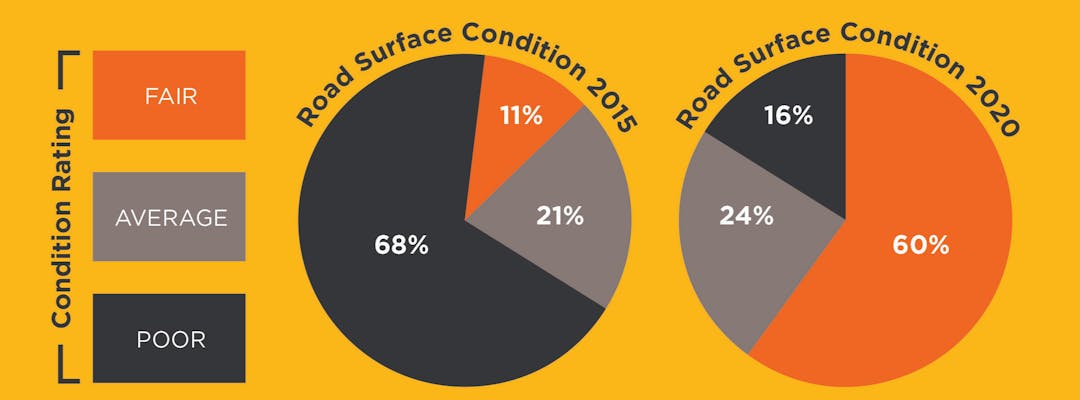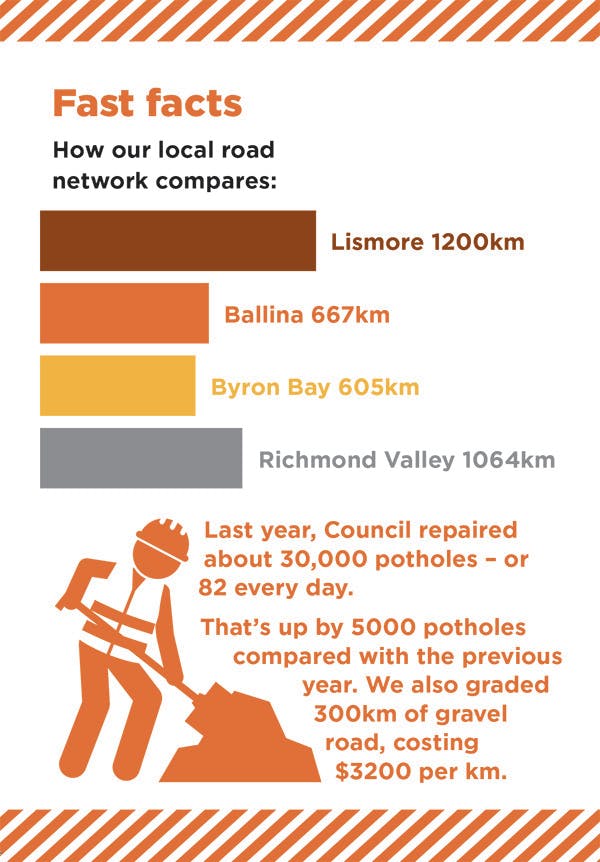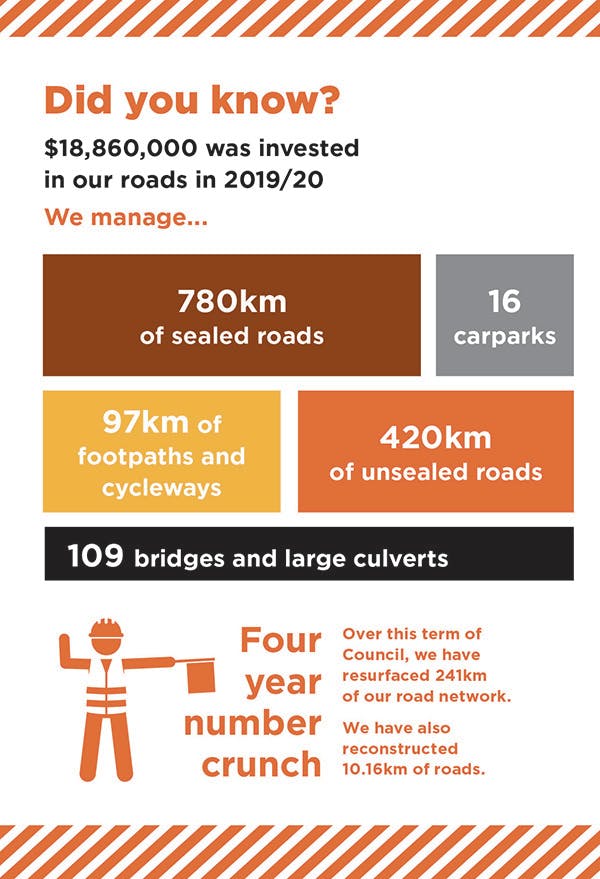This page has been archived, please visit the Your Say home page or Lismore City Council website for the most up to date information.
It is exciting to report that we have had some success in improving our road conditions in recent years.
This is largely thanks to our new strategy of resurfacing as many kilometres of bitumen as possible to ensure roads are repaired before they start to fail.
People often ask us why don’t we fix the worst roads first... and it's a good question. It’s the same reason why you need to paint a weatherboard house regularly. If you don’t paint, the weather will cause the paint to peel, allowing the wood to rot. So, you paint regularly to stop a bigger problem that's even more expensive.
Five years ago, we adopted a new approach that including more resurfacing (keeping the top-level road surface in good condition). This keeps the road waterproof and protects the expensive gravel foundation underneath from becoming wet and weak. This approach was recommended by experts to get the most life out of every road and get better value from our roads funding. However, one of the consequences of this change is that it takes us longer to get around to roads in very poor condition that need a full rebuild.
To measure improvements, we assessed the condition of our roads in 2015 and applied the same methodology in 2020 to capture real data and measure our performance. The comparison in the graphs above shows a marked improvement in the condition of our road network since we implemented this new approach to fixing roads.
In simple terms, because we have resurfaced 32% of our sealed road network over the last five years, it has improved the surface condition assessment significantly. The percentage of the network in 'poor' condition has reduced from 68% to 16%. Conversely, the percentage of the network that is in 'average' or 'fair' condition has improved from 32% to 84%.
This is great news and shows that our new approach is working. Over time, this will improve the whole road network and keep more of our expensive gravel foundations in good repair, costing us less in the long run.
 But there is still much more work to do, which requires ongoing investment. This financial year, Council is investing $26.09 million in our roads and associated infrastructure.
But there is still much more work to do, which requires ongoing investment. This financial year, Council is investing $26.09 million in our roads and associated infrastructure.
Unfortunately, this is not enough to make much headway into our backlog of roadworks. Lismore has one of the largest road networks in regional NSW, with a backlog that has been allowed to build up over many decades and now exceeds $70 million.
Recognising this historical under-investment, and in response to community expectations, in 2017 Council adopted its Delivery Program for 2017-2021. This included a proposed Special Rate Variation (SRV) to raise an additional $3.74 million annually for direct investment in roads.
However, Council struggled with the SRV application and ultimately resolved to withdraw its SRV application to the Independent Pricing & Regulatory Tribunal (IPART). Council also resolved in June this year to remove almost $4 million in road funding from Council’s annual budget.
This year we have been successful in obtaining additional road funding although these grants will focus on state roads and prioritise road safety issues.
Unfortunately, Council cannot rely on grant funding to continue at these increased levels, or to address our roadworks backlog, particularly for local streets and roads.
Despite our funding challenges, it is heartening to see the evidence showing we are making a difference using the road funding we have.
For more information on how we maintain roads, visit our page: Information on Maintaining our Roads.
This page has been archived, please visit the Your Say home page or Lismore City Council website for the most up to date information.
It is exciting to report that we have had some success in improving our road conditions in recent years.
This is largely thanks to our new strategy of resurfacing as many kilometres of bitumen as possible to ensure roads are repaired before they start to fail.
People often ask us why don’t we fix the worst roads first... and it's a good question. It’s the same reason why you need to paint a weatherboard house regularly. If you don’t paint, the weather will cause the paint to peel, allowing the wood to rot. So, you paint regularly to stop a bigger problem that's even more expensive.
Five years ago, we adopted a new approach that including more resurfacing (keeping the top-level road surface in good condition). This keeps the road waterproof and protects the expensive gravel foundation underneath from becoming wet and weak. This approach was recommended by experts to get the most life out of every road and get better value from our roads funding. However, one of the consequences of this change is that it takes us longer to get around to roads in very poor condition that need a full rebuild.
To measure improvements, we assessed the condition of our roads in 2015 and applied the same methodology in 2020 to capture real data and measure our performance. The comparison in the graphs above shows a marked improvement in the condition of our road network since we implemented this new approach to fixing roads.
In simple terms, because we have resurfaced 32% of our sealed road network over the last five years, it has improved the surface condition assessment significantly. The percentage of the network in 'poor' condition has reduced from 68% to 16%. Conversely, the percentage of the network that is in 'average' or 'fair' condition has improved from 32% to 84%.
This is great news and shows that our new approach is working. Over time, this will improve the whole road network and keep more of our expensive gravel foundations in good repair, costing us less in the long run.
 But there is still much more work to do, which requires ongoing investment. This financial year, Council is investing $26.09 million in our roads and associated infrastructure.
But there is still much more work to do, which requires ongoing investment. This financial year, Council is investing $26.09 million in our roads and associated infrastructure.
Unfortunately, this is not enough to make much headway into our backlog of roadworks. Lismore has one of the largest road networks in regional NSW, with a backlog that has been allowed to build up over many decades and now exceeds $70 million.
Recognising this historical under-investment, and in response to community expectations, in 2017 Council adopted its Delivery Program for 2017-2021. This included a proposed Special Rate Variation (SRV) to raise an additional $3.74 million annually for direct investment in roads.
However, Council struggled with the SRV application and ultimately resolved to withdraw its SRV application to the Independent Pricing & Regulatory Tribunal (IPART). Council also resolved in June this year to remove almost $4 million in road funding from Council’s annual budget.
This year we have been successful in obtaining additional road funding although these grants will focus on state roads and prioritise road safety issues.
Unfortunately, Council cannot rely on grant funding to continue at these increased levels, or to address our roadworks backlog, particularly for local streets and roads.
Despite our funding challenges, it is heartening to see the evidence showing we are making a difference using the road funding we have.
For more information on how we maintain roads, visit our page: Information on Maintaining our Roads.






